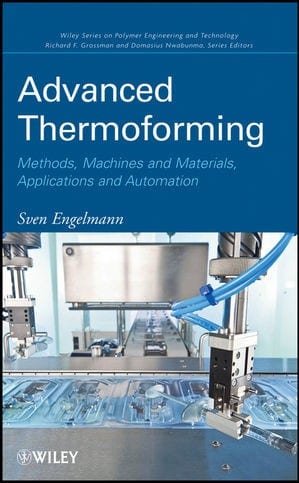 Advanced Thermoforming: Methods, Machines and Materials, Applications and Automation
Advanced Thermoforming: Methods, Machines and Materials, Applications and Automation
Sven Engelmann
ISBN: 978-0-470-49920-7
Hardcover
352 pages
US $149.95
Click here for more information
Reviewed by Dr Peter Martin, Reader, Queen’s University Belfast
The book, “Advanced Thermoforming: Methods, Machines and Materials, Applications and Automation”, is focussed on introducing the latest technological developments in the thermoforming of polymer materials. The work is deliberately industrially orientated and in the preface the author points out that his aim was to “focus on practical applications” and to “arouse interest” in the reader. The work is timely as many recent technological advances found in industry are not widely published and are absent from the relatively small number of textbooks that are currently available to readers interested in thermoforming.
The structure of the book is unusual as it contains a total of 42 separate chapters. These are of varying lengths and complexities that have either been written by the author alone or in cooperation with a selection of named industrial contacts. This gives the book the appearance of a collection of edited papers from multiple authors, rather than an instructional text. However, many of the chapters are essentially distilled from detailed conversations with industry experts and as a result they provide unique insights into the modern thermoforming industry.
The author’s approach to referencing is also very unconventional as neither lists of references nor a bibliography are provided within the book. Only a brief glossary of terms is included after chapter 42. Instead, most chapters contain either no citations to the work of others or a single reference given at the beginning of the chapter. Early in chapter 2 the author does state that “several very good books on the basics of thermoforming and thermoplastics have already been published”, but no list of these is provided to aid the reader. These omissions appear to run contrary to the author’s stated aim in chapter 1 that “this book is intended as a reference book”.
The book is essentially divided into 3 parts with the largest sections being devoted to the presentation of practical examples of thermoforming technologies. Chapters 1-3 provide an introduction to the book and a brief overview of the basic principles of extrusion and thermoforming. These sections are relatively brief as the author is at pains to stress that such information is already widely available elsewhere. However, they do serve to highlight the importance of the preceding extrusion stage to subsequent thermoforming operations.
Chapters 4-19 provide examples from the manufacture of technical parts. These largely focus on the commercially important automotive sector but also include wider examples from aerospace and domestic appliances. Together these chapters cover a wide range of practical examples that are interspersed with rich veins of technical details. These include the materials being used, the design of the parts and the production processes. Chapter 4 provides a very short 1 page introduction to this section which leaves the direction and interpretation of what follows almost entirely in the hands of the reader. In the subsequent chapters there is great variability in both the quantity and technical depth of the information presented, and the logic used to determine the order of the various chapters is also very unclear. For example, chapter 5 describes the niche area of ‘Antenna Radome Manufacturing’, but only focuses on the required properties of the polystyrene material. No details are given of how such parts are thermoformed. In contrast the technologies associated with the much larger area of automotive parts are scattered across many of the remaining chapters in the section. Several of these, such as chapters 10, 14 and 18, are less than 2 pages in length and as a result only provide a tantalising snapshot of the technology presented.
Chapters 20-42 mirror the structure of the section on technical parts and provide examples from the manufacture of packaging. However, these chapters are generally longer and more structured than those presented earlier. Specific advice is given in chapter 21 on how to optimise a thermoforming process and in chapters 22-25 guidance is provided on the analysis of films and products. This is followed by an overview of approaches to automation in chapter 26. The subsequent chapters then largely feature examples of thermoformed packaging, although many also contain valuable generic information of much wider practical relevance. A good example of this is chapter 27, entitled the “Production of Flowerpots”, which is the only chapter to provide detailed discussion of modern plug materials. Other chapters such as 33 (Peel and Reseal) and 36 (Production of Drinking Cups) provide lengthy instructional narrative and illustrations, whereas chapters 21 and 38 include the analysis of extensive experimental results. It is a feature throughout that the author has chosen not to provide direction on the choice of particular technologies, but to simply show examples of what a selected number of companies are using. As a result most chapters end abruptly once the particular example is presented, and despite statements to the contrary on the book cover, this text does not make recommendations and for the most part it does not consider alternatives nor the advantages and disadvantages of many of the technologies that are presented. Further interpretation is left firmly with the reader, as is exemplified by the absence of any further commentary on the contents following the last example presented in chapter 42.
Overall, this text presents an impressive variety of advanced thermoforming technologies in a very readable form. It will be of interest to a general reader, although for greatest benefit many of the examples covered require a basic knowledge of both polymer materials and thermoforming. The work is strongest in providing numerous examples of applications from industry, and the approach of speaking to industry experts has given parts of the book an unrivalled level of technical detail on practical thermoforming. Readers from industry and academic researchers will find particular chapters extremely valuable, but may be disappointed by the minimal guidance provided on technology selection and the lack of references to alternative sources of information.














